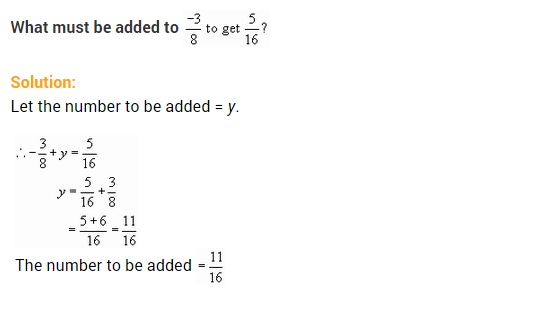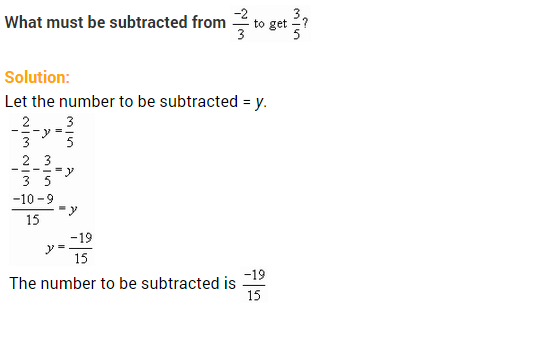If you are looking for Extra questions for class 8 maths Rational Numbers , You have reached the correct page. You can also use these extra questions like Rational numbers class 8 worksheets with answers.
Rational Numbers Class 8 Extra Questions Maths Chapter 1
Extra Questions for Class 8 Maths Chapter 1 Rational Numbers
Rational Numbers Class 8 Extra Questions Very Short Answer Type
Question 1.
Pick up the rational numbers from the following numbers.
\(\frac { 6 }{ 7 }\), \(\frac { -1 }{ 2 }\), 0, \(\frac { 1 }{ 0 }\), \(\frac { 100 }{ 0 }\)
Solution:
Since rational numbers are in the form of \(\frac { a }{ b }\) where b ≠ 0.
Only \(\frac { 6 }{ 7 }\), \(\frac { -1 }{ 2 }\) and 0 are the rational numbers.
Question 2.
Find the reciprocal of the following rational numbers:
(a) \(\frac { -3 }{ 4 }\)
(b) 0
(c) \(\frac { 6 }{ 11 }\)
(d) \(\frac { 5 }{ -9 }\)
Solution:
(a) Reciprocal of \(\frac { -3 }{ 4 }\) is \(\frac { -4 }{ 3 }\)
(b) Reciprocal of 0, i.e. \(\frac { 1 }{ 0 }\) is not defined.
(c) Reciprocal of \(\frac { 6 }{ 11 }\) is \(\frac { 11 }{ 6 }\)
(d) Reciprocal of \(\frac { 5 }{ -9 }\) = \(\frac { -9 }{ 5 }\)
Question 3.
Write two such rational numbers whose multiplicative inverse is same as they are.
Solution:
Reciprocal of 1 = \(\frac { 1 }{ 1 }\) = 1
Reciprocal of -1 = \(\frac { 1 }{ -1 }\) = -1
Hence, the required rational numbers are -1 and 1.
Question 4.
What properties, the following expressions show?
(i) \(\frac { 2 }{ 3 } +\frac { 4 }{ 5 } =\frac { 4 }{ 5 } +\frac { 2 }{ 3 }\)
(ii) \(\frac { 1 }{ 3 } \times \frac { 2 }{ 3 } =\frac { 2 }{ 3 } \times \frac { 1 }{ 3 }\)
Solution:
(i) \(\frac { 2 }{ 3 } +\frac { 4 }{ 5 } =\frac { 4 }{ 5 } +\frac { 2 }{ 3 }\) shows the commutative property of addition of rational numbers.
(ii) \(\frac { 1 }{ 3 } \times \frac { 2 }{ 3 } =\frac { 2 }{ 3 } \times \frac { 1 }{ 3 }\) shows the commutative property of multiplication of rational numbers.
Question 5.
What is the multiplicative identity of rational numbers?
Solution:
1 is the multiplicating identity of rational numbers.
Question 6.
What is the additive identity of rational numbers?
Solution:
0 is the additive identity of rational numbers.
Question 7.
If a = \(\frac { 1 }{ 2 }\), b = \(\frac { 3 }{ 4 }\), verify the following:
(i) a × b = b × a
(ii) a + b = b + a
Solution:


Question 8.
Multiply \(\frac { 5 }{ 8 }\) by the reciprocal of \(\frac { -3 }{ 8 }\)
Solution:

Question 9.
Find a rational number between \(\frac { 1 }{ 2 }\) and \(\frac { 1 }{ 3 }\).
Solution:
Rational number between

Question 10.
Write the additive inverse of the following:
(a) \(\frac { -6 }{ 7 }\)
(b) \(\frac { 101 }{ 213 }\)
Solution:

Question 11.
Write any 5 rational numbers between \(\frac { -5 }{ 6 }\) and \(\frac { 7 }{ 8 }\). (NCERT Exemplar)
Solution:

Question 12.
Identify the rational number which is different from the other three : \(\frac { 2 }{ 3 }\), \(\frac { -4 }{ 5 }\), \(\frac { 1 }{ 2 }\), \(\frac { 1 }{ 3 }\). Explain your reasoning.
Solution:
\(\frac { -4 }{ 5 }\) is the rational number which is different from the other three, as it lies on the left side of zero while others lie on the right side of zero on the number line.
Rational Numbers Class 8 Extra Questions Short Answer Type
Question 13.
Calculate the following:

Solution:


Question 14.
Represent the following rational numbers on number lines.
(a) \(\frac { -2 }{ 3 }\)
(b) \(\frac { 3 }{ 4 }\)
(c) \(\frac { 3 }{ 2 }\)
Solution:

Question 15.
Find 7 rational numbers between \(\frac { 1 }{ 3 }\) and \(\frac { 1 }{ 2 }\).
Solution:

Question 16.
Show that:

Solution:

Question 17.
If x = \(\frac { 1 }{ 2 }\), y = \(\frac { -2 }{ 3 }\) and z = \(\frac { 1 }{ 4 }\), verify that x × (y × z) = (x × y) × z.
Solution:
We have x = \(\frac { 1 }{ 2 }\), y = \(\frac { -2 }{ 3 }\) and z = \(\frac { 1 }{ 4 }\)
LHS = x × (y × z)

Question 18.
If the cost of 4\(\frac { 1 }{ 2 }\) litres of milk is ₹89\(\frac { 1 }{ 2 }\), find the cost of 1 litre of milk.
Solution:

Question 19.
The product of two rational numbers is \(\frac { 15 }{ 56 }\). If one of the numbers is \(\frac { -5 }{ 48 }\), find the other.
Solution:
Product of two rational numbers = \(\frac { 15 }{ 56 }\)
One number = \(\frac { -5 }{ 48 }\)
Other number = Product ÷ First number

Hence, the other number = \(\frac { -18 }{ 7 }\)
Question 20.
Let O, P and Z represent the numbers 0, 3 and -5 respectively on the number line. Points Q, R and S are between O and P such that OQ = QR = RS = SP. (NCERT Exemplar)
What are the rational numbers represented by the points Q, R and S. Next choose a point T between Z and 0 so that ZT = TO. Which rational number does T represent?
Solution:

As OQ = QR = RS = SP and OQ + QR + RS + SP = OP
therefore Q, R and S divide OP into four equal parts.

Question 21.
Let a, b, c be the three rational numbers where a = \(\frac { 2 }{ 3 }\), b = \(\frac { 4 }{ 5 }\) and c = \(\frac { -5 }{ 6 }\) (NCERT Exemplar)
Verify:
(i) a + (b + c) = (a + b) + c (Associative property of addition)
(ii) a × (b × c) – (a × b) × c (Associative property of multiplication)
Solution:


Rational Numbers Class 8 Extra Questions Higher Order Thinking Skills (HOTS)
Question 22.
Rajni had a certain amount of money in her purse. She spent ₹ 10\(\frac { 1 }{ 4 }\) in the school canteen, bought a gift worth ₹ 25\(\frac { 3 }{ 4 }\) and gave ₹ 16\(\frac { 1 }{ 2 }\) to her friend. How much she have to begin with?
Solution:
Amount given to school canteen = ₹ 10\(\frac { 1 }{ 4 }\)
Amount given to buy gift = ₹ 25\(\frac { 3 }{ 4 }\)
Amount given to her friend = ₹ 16\(\frac { 1 }{ 2 }\)
To begin with Rajni had

Question 23.
One-third of a group of people are men. If the number of women is 200 more than the men, find the total number of people.
Solution:
Number of men in the group = \(\frac { 1 }{ 3 }\) of the group
Number of women = 1 – \(\frac { 1 }{ 3 }\) = \(\frac { 2 }{ 3 }\)
Difference between the number of men and women = \(\frac { 2 }{ 3 }\) – \(\frac { 1 }{ 3 }\) = \(\frac { 1 }{ 3 }\)
If difference is \(\frac { 1 }{ 3 }\), then total number of people = 1
If difference is 200, then total number of people
= 200 ÷ \(\frac { 1 }{ 3 }\)
= 200 × 3 = 600
Hence, the total number of people = 600
Question 24.
Fill in the blanks:
(a) Numbers of rational numbers between two rational numbers is ……….

Solution:
(a) Countless
(b) \(\frac { 6 }{ 11 }\)
(c) \(\frac { -3 }{ 2 }\)
(d) \(\frac { 3 }{ 5 }\)
(e) Commutative
(f) associative
(g) equivalent
(h) \(\frac { 3 }{ 11 }\)


















